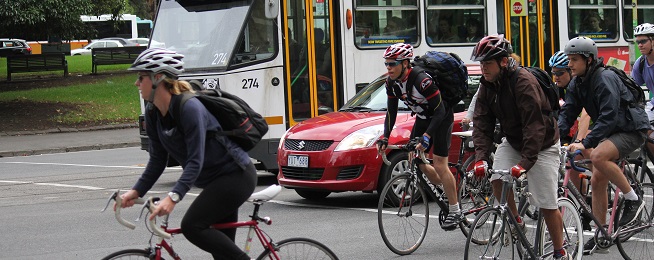The City of Melbourne has proposed radically improved priority for trams on city streets, a move that would significantly improve convenience and safety for bikes using those same streets.
Currently Melbourne trams spend 17 per cent of their time waiting at traffic lights.
But in public transport best-practice cities, such as Zurich, trams spend just 6 per cent of their time at lights.
In Melbourne, where tram signals and bike signals can be twinned together, this could greatly improve the efficiency and attractiveness of bike travel.
Zurich gives trams absolute priority at traffic lights, which is as it should be: why should a handful of people in cars get the same priority as 100 people in a tram.
And on bikes, scores of people can scurry through a traffic light phase in the same time as a mere handful of car occupants.
The concept has been floated in a discussion paper on public transport released during the lead up to a City of Melbourne Transport Strategy.
The paper says that a world-class public transport system is critical to a liveable, prosperous and sustainable city.
"Mass public transport is the most space-efficient means of moving high volumes of people across medium to long distances.
"Our public transport network is under strain. The number of people living, working and visiting the municipality is growing faster than can be accommodated by current services and committed public transport projects."
"The crucial Melbourne Metro Rail Tunnel will be at capacity soon after completion.”
The paper says that 80 per cent of Melbourne’s tram routes run in mixed traffic while dedicated bus lanes are very limited.
"This means traffic congestion undermines the reliability, efficiency and frequency of trams and buses. Reducing these delays would allow more services to run without the need to buy more trams and buses, giving such improvements a high benefit-cost ratio."
"For peak period trips to the central city, trams carry at least twice as many people as cars on roads including Nicholson Street, Brunswick Street, Smith Street, Victoria Street and Bridge Road. On St Kilda Road the ratio of tram passengers to car occupants is more than five to one."
The paper refers to technology that enables trams to communicate priority to traffic signals, and to cars to alert them to keep tracks clear. And there is technology that can enforce the law if priority is breached by other road users.
There is also a call to upgrade tram stops so that they are bother more universally accessible and better integrate them with the street and bike infrastructure, such as in Macarthur Street in the Parliamentary precinct.
Dedicated road space for trams and buses is also on the agenda. Parking reform is another factor: one of the reasons trams speeds in the inner city can average just 11 km/h is that they are blocked by cars trying to negotiate parking spaces.


